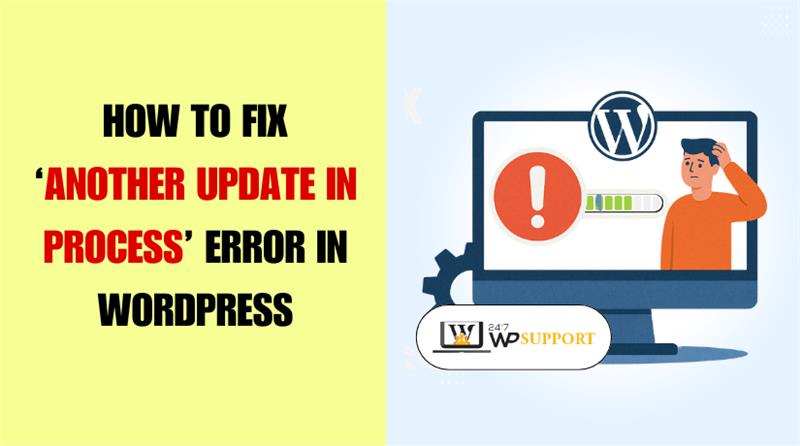
How to Fix ‘Another Update in Process’ Error in WordPress
Last updated on July 18th, 2025 at 05:35 am
Introduction
If you use WordPress, you’ve likely seen the error message: “Another update is currently in progress.”
It often causes stress, especially if you’re not sure why it happened. It typically appears when you attempt to upgrade your WordPress plugins, themes, or core. The process gets stuck, and you’re locked out of making any further updates.
This error is common. It mostly happens when an earlier update process didn’t finish properly. Sometimes, the update gets interrupted due to a slow server, a crash, or an issue with your hosting provider.
WordPress stops other updates from running when this occurs. It’s a safety feature to stop multiple updates at once. But when the system doesn’t clear the lock, your dashboard remains frozen.
You might notice the following:
- WordPress, plugins, and themes cannot be updated.
- A message says “Another update currently in progress.”
- The site might act like it’s stuck in update mode.
- The dashboard shows no active updates, but you’re still locked out.
This happens because WordPress creates a special database entry during updates. That entry is called core_updater.lock. If that entry doesn’t get removed automatically, you see the error.
We’ll lead you through several fixes in this guide. To address this problem, you don’t have to be an expert in technology.
What Causes the ‘Another Update in Progress’ Error in WordPress?
It is beneficial to know the cause of the mistake before attempting to fix it. This error usually appears when WordPress thinks an update is still running, even when it’s not. The main reason is a lock left behind in your site’s database. That lock is called core_updater.lock.
Below are the most common reasons why this happens:
- Interrupted or Incomplete Updates
WordPress updates should run smoothly from start to finish. But if the process gets stopped midway, the update lock may stay behind.
This often happens when:
- The internet connection drops during an update.
- The browser is closed before the update finishes.
- The server times out or gets overloaded.
- A plugin crashes while updating the core.
- Hosting Server Limitations or Timeouts
Low-quality or shared hosting environments can cause update delays. If the server is too slow or times out, the update may fail.
Look out for:
- Low PHP memory limit on your hosting.
- Overloaded shared hosting environments.
- Delayed response from the server.
- Hosting-side firewalls interrupting update scripts.
- Conflicts with Background Update Processes
WordPress often checks for updates in the background. If that process overlaps with manual updates, errors may occur.
This might happen due to:
- Auto-updates run while you launch a manual update.
- Plugin or theme auto-updates start at the same time.
- Cron jobs are triggering simultaneous update requests.
- WordPress Database Lock or Crash
The database can crash or freeze during an update. When that happens, WordPress doesn’t remove the update lock, and the dashboard gets stuck.
Causes include:
- The server crashes during the update.
- Poorly coded plugins are affecting database operations.
- Low database space or corrupted tables.
- Stuck WordPress Dashboard with No Active Updates
Sometimes, no update is visibly running, but the system still blocks updates. That’s because the lock entry (core_updater.lock) was never cleared.
You may see:
- No sign of updates in progress.
- “Another update currently in progress” message.
- Unable to update plugins, themes, or core files.
Method 1 – Fix the Error Using phpMyAdmin
One of the most reliable ways to fix this error is by using phpMyAdmin. This method involves removing the update lock entry from your WordPress database.
You may easily follow this procedure if you have access to your hosting control panel, such as Plesk or cPanel. It’s a safe process if you do it step-by-step.
The goal here is to delete the database record that tells WordPress an update is in progress. This record is saved under the name core_updater.lock in your wp_options table.
Let’s walk through the full steps.
Step-by-Step Guide to Remove core_updater.lock via phpMyAdmin
Log into your hosting account first.
Then follow these steps:
- Open cPanel or any other hosting control panel.
- Track down and choose phpMyAdmin from the “Databases” panel.
- Select your WordPress database from the left side in phpMyAdmin.
- Click on the wp_options table.
(Note: Your table may be called wp_xxx_options depending on your prefix.) - Do a search for “core_updater.lock”
- Press Go to search.
- You’ll see one result with the option_name as core_updater.lock.
- Click Delete to remove this row from the table.
- Confirm deletion if asked.
- Return to the WordPress dashboard, then reload the page.
The error message should now be gone.
Why This Works
The core_updater.lock record is what causes WordPress to block further updates. Deleting it tells WordPress that no updates are running.
This solution is quick and does not harm your site. You’re only deleting one temporary entry.
Safety Tip Before Making Changes
Before making any changes to your database:
- Create a database backup.
- Use your hosting panel’s backup option or a plugin like UpdraftPlus.
In the event that something goes wrong, this gives you piece of mind.
Method 2 – Use WP-CLI to Fix the Error
This problem can be quickly and effectively fixed with WP-CLI if you feel comfortable using the command line. The WordPress Command Line Interface is referred to as WP-CLI. It enables you to use your server terminal to control your WordPress website.
Using WP-CLI, you can delete the core_updater.lock entry in just one command. This is helpful when phpMyAdmin is not working, or if you prefer command-line solutions.
Let’s examine each stage in detail.
Step 1: Access Your Server via SSH
You must first use SSH (Secure Shell) to connect to your server. This gives you access to run commands.
Here’s how to do it:
- Use a program such as Terminal (for Mac/Linux) or PuTTY (for Windows).
- Enter your password and SSH username to log in.
- Use the cd command to navigate to the root directory of WordPress.
Example:
cd /home/username/public_html
Make sure you’re in the correct WordPress folder.
Step 2: Run the Command to Delete the Lock
Once you’re in the WordPress root, run this WP-CLI command:
wp option delete core_updater.lock
Use the cd command to navigate to the root directory of WordPress.
The following message will appear if the command is successful:
Success: Deleted ‘core_updater.lock’ option.
That’s it! You’ve removed the update lock.
Why Use WP-CLI?
There are several reasons to use WP-CLI:
- It’s faster than using phpMyAdmin.
- It works even when your dashboard is stuck.
- It avoids the need for plugins or database panels.
- Great for developers and advanced users.
Before You Use WP-CLI
Make sure:
- Your hosting provider supports WP-CLI.
- SSH access is enabled.
- You have basic knowledge of terminal commands.
If you’re unsure, check with your host or use phpMyAdmin instead.
Alternative Fixes – Plugin and .Maintenance File Method
If you’re not comfortable using phpMyAdmin or WP-CLI, don’t worry. The WordPress problem “Another update currently in progress” can be resolved in a few different ways. In this section, we’ll show two simple alternatives:
- Use a WordPress plugin.
- Delete the .maintenance file from your site.
Both methods are safe and beginner-friendly.
Option 1: Use the “Fix Another Update In Progress” Plugin
This free plugin is designed to remove the update lock with one click. For people who want a fast fix without working with code or databases, it’s perfect.
Here’s how to use it:
- Open your WordPress dashboard and log in.
- Go to Plugins → Add New.
- In the search bar, type “Fix Another Update In Progress.”
- Hit the ‘Install Now’ button, followed by ‘Activate’ to enable it.
- Navigate to Settings → Fix Another Update In Progress after activation.
- Press the button labeled “Fix WordPress Update Lock.”
The core_updater.lock record will be deleted from your database by the plugin.
If you decide you no longer need the plugin after finishing, you can remove it.
Benefits of using this plugin:
- No need to use phpMyAdmin or WP-CLI.
- Takes only a few seconds to run.
- Good for non-technical users.
Option 2: Delete the .maintenance File
Sometimes the issue is caused by a leftover .maintenance file. WordPress creates this file during updates, and it should be removed automatically. But if the process fails, the file stays and blocks updates.
To fix it, do the following:
- Open your hosting panel (such as cPanel) and log in.
- Open the File Manager.
- Navigate to the root directory of WordPress, which is typically public_html.
- Find a file with the extension “.maintenance.”
- Use the right-click menu to remove the file.
- WordPress gets informed that the update is finished when the.maintenance file is deleted.
Why this works:
- Deleting the .maintenance file tells WordPress the update is complete.
- It allows the dashboard to work normally again.
Both of these methods are quick and user-friendly. If problems persist, there may be a deeper disagreement or a cache issue. We’ll go over how to clear the cache and prevent this problem in the future in the next section.
Clear WordPress and Browser Cache
After fixing the “Another update currently in progress” error, it’s a good idea to clear your cache. By doing this, stored data that might still display the previous error message is removed. It also ensures that your dashboard loads the most recent version of your site.
Many WordPress users forget this step. But caching can keep an old version of the update lock message—even when the issue is already fixed.
Here’s what you can do:
- Clear Browser Cache
- Press Ctrl + Shift + R to hard-refresh the page.
- Alternately, remove the cached files and images in your browser’s preferences.
- Restart the browser and check the dashboard again.
- Clear Plugin Cache
If you use caching plugins, clear their stored data.
Popular plugins include:
- W3 Total Cache: Go to Performance → Dashboard → Empty All Caches.
- WP Super Cache: Go to Settings → WP Super Cache → Delete Cache.
- LiteSpeed Cache: Go to LiteSpeed → Toolbox → Purge All.
- Server-Level Cache
If your host uses built-in caching (like SiteGround, Bluehost, or Hostinger), clear it from your hosting control panel.
This ensures the server serves fresh content to your browser.
Tips to Prevent the Update Error in the Future
While this error is common, there are simple ways to avoid it in the future.
- Avoid Interrupting Updates
- Before you refresh the page, wait for the update to finish.
- Don’t close the tab or switch browsers during updates.
- Keep Plugins and Themes Updated
- Outdated themes or plugins can cause update conflicts.
- Update them regularly, one at a time if possible.
- Use Reliable Hosting
- Choose hosting that supports stable WordPress performance.
- Seek for hosts that provide WP-CLI access and automatic backups.
- Use a Staging Site for Testing
- First, make changes to a staging version.
- This helps in identifying problems before implementing them on your live website.
- Backup Your Website Often
- Always create backups before running updates.
- Use plugins like UpdraftPlus or BlogVault for easy backups.
Conclusion
Fixing WordPress errors doesn’t have to be stressful or time-consuming. With the right tools and guidance, even frustrating issues like update locks can be resolved quickly. If you’re unsure about making changes to your database or using advanced tools like WP-CLI, it’s always safer to ask for help. At 24×7 WP Support, our team is available day and night to handle WordPress errors, stuck updates, broken themes, and more. Whether you’re managing a business site or personal blog, we ensure everything runs smoothly—so you can focus on what matters.
Need help right now? Contact 24×7 WP Support and get expert assistance within minutes.
Looking for more WordPress help? Subscribe to our YouTube Channel for expert video tutorials. Join us on Twitter and Facebook for updates, tips, and insights.



